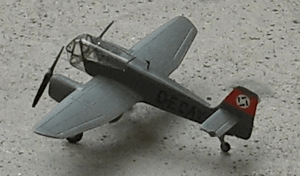Akaflieg Berlin B9
| Akaflieg Berlin B 9 | |
|---|---|
 | |
| A model of the B 9 | |
| Role | Experimental aircraft |
| National origin | Germany |
| Manufacturer | Akaflieg Berlin |
| First flight | 1943 |
| Status | Prototype only |
| Number built | 1 |
The Akaflieg Berlin B 9 was a twin-engined[1] experimental aircraft, developed by Akaflieg Berlin and Flugtechnische Fachgruppe in the 1940s. It was designed to examine the benefits of having a pilot in a prone position. The aircraft was flown in 1943, but was eventually abandoned.
Specifications
General characteristics
- Crew: One
- Length: 6.06 m (19 ft 11 in)
- Wingspan: 9.4 m (30 ft 10 in)
- Height: 2.32 m (7 ft 7 in)
- Wing area: 11.9 m2 (128 sq ft)
- Empty weight: 940 kg (2,072 lb)
- Gross weight: 1,115 kg (2,458 lb)
- Fuel capacity: 95L
- Powerplant: 2 × Hirth HM 500 , 77 kW (103 hp)105PS each
Performance
- Maximum speed: 250 km/h (155 mph; 135 kn)
- Service ceiling: 4,000 m (13,000 ft)
See also
- Aircraft of comparable role, configuration and era
- Related lists
Notes
- ↑ Lerche, Hans-Werner. "Luftwaffe test pilot: flying captured Allied aircraft of World War 2". Jane's: 130.
References
- Bert Hartmann. "FFG Berlin B 9" (in German). Retrieved December 4, 2009.
- "Berlin B9 Experimental Aircraft". Retrieved December 4, 2011.
This article is issued from
Wikipedia.
The text is licensed under Creative Commons - Attribution - Sharealike.
Additional terms may apply for the media files.